应用语言学论文
- 格式:docx
- 大小:40.90 KB
- 文档页数:16

Critical Review姓名:常首鸣班级:08级外应2班学号:2008142 专业:翻译理论及实践Article: Cohesion Is Not Coherence Author: Patricia L. Carrell1.Introduction:The author of the article is Patricia L. Carrell, a professor of linguistics at Southern Illinois University at Carbondale where she teaches in the M.A. in EFL/ESL program, and she is currently visiting Professor of ESL at the University of Hawaii. Her article, Cohesion Is Not Coherence, is published in 1982 when a tremendous attention has been paid to the field of studying text as a unit of language beyond the sentence level, and almost at the same time many researchers of first language as well as applied and second language researchers have been proposed a variety of approaches and theoretical accounts in the field, trying to explain the fundamental properties of text. These approaches are called text grammars, among which Michael Halliday and Rugaiya Hasan’s cohesion theory has been the most influential one.The purpose of the article is to criticise cohesion theory as a criterion of textual coherence from the perspective of schema-theoretical view which has taken the reader into caaount, and which has viewed both reading and writing as an interactive process involving the writer and the reader, as well as the text.Personally the article is worth writing for it has not only challenged the cohesion theroy which has been regarded as a measure of textual coherence, pointing out the weakness of the theory, but provided some penetrating points which, I think, is a insightful contribution to the ESL research, especially on writing and reading.The article is a well-origanized writing, especially the first paragraph which functions as an abstract. In terms of the elements a complete abstract should have, thisparagraph could be a model writing on the level of both structure and logic.2.Body2.1 On the Introduction Part of This Articlethe writer clearly and concisely reviews the background information that Halliday and Hasan proposed the concept of cohesion, and shows the organization of her article: the first part reviews Halliday and Hasan’s cohesion theory as a criterion of textual coherence; the scond part criticizes the cohesive view of coherence both theoretically and empirically; the third and final part relates this criticism of cohesion as a measure of coherence to the applied fiel d—the teaching of writing and reading in a second language, especially ESL.2.2On Reviewing Cohesion TheoryCarrell objectively and fairly describes cohesion theory and categorise it as the traditional text grammar. The theory treats text in the field of linguistics. After pointing out that register and cohesion, the letter of which is Halliday and Hasan’s main concern, are the combination of coherence, or texture which establishes what is the properities of texts in English, and what it is that distinguishes a text from a disconnected sequence of sentence, the author stating that cohesion concerns semantic relations rather than content of passeges or textual meaning; and then she briefly summarizes the four cohesive ties or relations—reference, substituation, conjunction and lexical cohesion—which Halliday and Hasan believe to be the resources for creating texture, or coherence.Finally Carrell concludes that Halliday and Hasan’s mian point appears to be that coherence of content alone is not enough to produce a coherent text, and there must be some additional device, such as ochesive ties, to make a text coherent.2.3On The Criticism Of The Cohesive View Of Coherence2.3.1 From the Theoretical ConsiderationsCarrell has briefly reviewed the criticism towards the cohesion view of textual coherence from different perspectives, such as that of Karen Feathers’ which arguesthat cohesion theory operates on the superfical surface structure of a text in establishing the cohesive ties.However the criticism of this article is in line with schema-theoretical views of text processing. The theoretical criticism emanates from Morgan and Sellner’s opinion. They sharply state that text grammars, including cohesion theory, talk about text analisis just for the sake of linguistic analysis for these approaches ignore a crucial and indispensable element in the text processin g—reader. Language is the reflection of the real world, and text is produced for reader.From the point of schems-theory, Morgan and sellner argue that Halliday and Hasan mistakingly take certain aspects of linguistic forms, namely cohesive ties as the cause, not the effect, of coherence. To convince the suggestion, they examine the first and simplest example in Halliday and Hasan’s book, Cohesion in English published in 1975. And then they state that Halliday and Hasan provide no reason in their notion. In the end, Carrell maintains the idea that text coheres not because the existence ofo lexical cohesive ties, but because readers have access to interpreting the schems in text. Without such a schems text will fail to cohere.2.3.2 From Empirical StudiesOn the empirical criticism part, Carrell uses three separate empirical studies to support Morgan and Sellner’s theoretical criticism of Halliday and Hasan’s notion. The first study carried out by Tierney and Mosenthal is to examine the extent to which Halliday and Hasan’s cohesion concept correlated with coherence. They find that toic or content appears to affect the writer’s choice in using cohesive ties. The study indicates that a cohesion index is causally unrelated to a text’s coherence. The second experiment by Freebody and Anderson shows the effects of three different levels of cohesion on reaers’understanding of written texts. The experiment also indicates that vocablary difficulty had a dramatic effect on understanding, but the amount of cohesion did not. The last empirical study by Steffensen who studied the interactive effects of both cohesive ties and cultural background knowledge on readers’comprehension of short prose texts. Steffensen found that causal and adversaitve cohesive elements were recalled better by readers from the text of theirown culture than the text of foreign culture. It suggests that cultural elements will cause the loss the textual cohesion. In other words, without the background schema underlying the text the cohesive ties will not produce a coherent text on the part of readers.2.4 Implications For Second Language/ESLThe critical of the paper on cohesiontheory in the light of schema-theory is to caytion those in second language teaching, especially in ESL, not to think that cohesion theory will be a panacea to solve reading and writing problem at the level of text. A coferent text will likely be coheisve, not of necessary, that is only an effect of the coherent content.Cohesion theory is worth studing. However it is not an measure of coherence of a text.2.5EvaluationAfter reading the article, we could gain a clear idea from the well-organized structure. Excellence of the article lies in the methodology used in it, that is, the theoretical criticism supported by the the empirical work which is carried out upon the same theoretical framework. However the limitations of the article are also its strengths. On the theoretical part, the critical opinion mainly comes from other researchers rather than Carrell herself; and on the empirical part, the three separate empirical studies are not finished by Carrell.3.ConclusionThe article criticises the concept of cohesion as a measure of the coherence, pointing out that the notion hold by Halliday and Hasan is in line with the linguistic analysis. With the orientation of schema-theory, the auhtor strongly criticises cohesion theory which fails to take the contribution of readers’into consideration in text processing, and objectively sates that cohesion theory hold by many researchers, especially in second language teaching/ESL, will not be a ultimate solution to writing and reading problem. The article has drawn some critical insight towards the second languageteaching and learning, which has been supported theoretically and empirically. The article is thought provoking.REFERENCES:Bobrow, D. G., and D. A. Norman. 1975. Some principles of memory schemata. In D.G. Bobrow and A. M. Collins ( Eds. ), Representation and understanding:Studies in cognitive science. New York: Academic Press.Carpenter, C., and J. Hunter. 1982. Functional exercises: Improving overall coherence in ESL writing. TESOL Quarterly 15, 4:425-434.Feathers, K. 1981. Text unity: A semantic perspective on mapping cohesion and coherence. Unpublished paper, Indiana University.Freebody, P., and R. C. Anderson. 1981. Effects of vocabulary difficulty, text cohesion, and schema availability on reading comprehension. Technical Report No. 225, Center for the Study of Reading. Champaign, IL: University of Illinois.Fries, C. 1952. The structure of English. New York: Harcourt.Goodin, G., and K. Perkins. 1982. Discourse analysis and the art of coherence.College English 44: 57-63.Hagerup-Neilsen, A. R. 1977. Role of macrostructures and linguistic connective in comprehending familiar and unfamiliar written discourse. Unpublished doctoral dissertation, University of Minnesota.Halliday, M. A. K., and R. Hasan. 1976. Cohesion in English. London: Longman. Harris, Z. 1970. Papers in structural and transformational linguistics. Dordrecht: D.Reidel.Hasan, R. 1978. On the notion of a text. In J. S. Petöfi (Ed.), Text vs. sentence.Hamburg: H. Buske.Kintsch, W. 1974. The representation of meaning in memory. Hillsdale, NJ: Lawrence Erlbaum Associates.Levy, D. M. 1979. Communicative goals and strategies: Between discourse and syntax.In T. Givon (Ed.), Syntax and semantics, Vol. 12: Discourse and syntax. New York: Academic Press.Longacre, R. 1972. Hierarchy and universality of discourse constituents in New Guinea languages. Washington, DC: Georgetown University Press. Longacre, R. 1968. Discourse, paragraph and sentence structure in selected Philippine languages. Santa Ana, CA: Summer Institute of Linguistics. Mandler, J. M., and N. S. Johnson. 1977. Remembrance of things parsed: Story structure and recall. Cognitive Psychology 9: 111-151.Menke, S. A. 1981. The noun phrase as a cohesive force in English text grammar.Unpublished paper presented at the First Midwest Regional TESOL Conference. Morgan, J. L., and M. B. Sellner. 1980. Discourse and linguistic theory. In R. J. Sp iro, B. C. Bertram, and W. F. Brewer ( Eds. ), Theoretical issues in readingcomprehension. Hillsdale, NJ: Lawrence Erlbaum Associates.Pike, K. 1967. Language in relation to a unified theory of the structure of human behavior. The Hague: Mounton.Rumelhart, D. L. 1975. Notes on a schema for stories. In D. G. Bobrow and A. M.Collins ( Eds. ), Representation and understanding: Studies in cognitive science.New York: Academic Press.Steffensen, M. S. 1981. Register, cohesion, and cross-cultural reading comprehension. Technical Report No. 220, Center for the Study of Reading.Champaign, IL:University of Illinois.Stein, N. L., and C. G. Glenn. 1979. An analysis of story comprehension in elementary school children. In R. O. Freedle (Ed.), Discourse processing: New directions. Norwood, NJ: Ablex.Thorndyke, P. W. 1977. Cognitive structures in comprehension and memory of narrative discourse. Cognitive Psychology 9: 77-110.Tierney, R. J., and J. H,. Mosenthal. 1980. Discourse comprehension and production: Analyzing text structure and cohesion. Technical Report No. 152, Center for the Study of Reading, Champaign, IL: University of Illinois.Tierney, R. J., and J. H. Mosenthal. 1981. The cohesion concept’s relationship to the coherence of text. Technical Report No. 221, Center for the Study of Reading.Champaign, IL: University of Illinois.van Dijk, T. A. 1972. Semantic macro-structures and knowledge frames in discourse comprehension. In M. A. Just and P. A. Carpenter ( Eds. ), Cognitive processes in comprehension. Hillsdale, NJ: Lawrence Erlbaum Associates.van Dijk, T. A. 1977. Text and context. London: Longman.Entry 1 Analyzing Legal Texts Within the Framework of Interpersonal Metafunction in the Context of Translation It is a thesis attempting to discuss translation methods pertaining to power preservation in the English to Chinese translation of legislative text. As a matter of fact, people mainly adopt a linguistic approach to the English to Chinese translation of legislative text with other external factors neglected. As one of the most important external factors, the role of power in legal text translation is stressed by the author in this thesis. The theoretical framework of this thesis is one of Halliday’s metafunctions, the interpersonal function.When I first came across this thesis, I felt a little excited because it is where my own interest lies and the research question is attractive. But to my disappointment, it doesn’t meet my expectation. First, the abstract part is not well organized and clearly stated. After finishing reading this part, I am almost lost. Although the subject matter of the thesis is clearly stated, it lacks research findings. Besides, in the last sentence “the result of the study may provide some implications for legal translation in general’, the writer fails to give the concrete implications of the study. Thus, it leaves its readers in confusion. As for the literature review which is included in the introduction part, it is also not very satisfactory. The author just makes a list of relevant materials and fails to elaborate the basis and premises of the research.Apart from the weakness that I have discussed above, it do does well in some aspect. Take its microstructure for example, it does not only logically arranged but clearly stated as well. Furthermore, this thesis brings a fresh air to legal language studies by adopting the top-down research methodology.The author is suggested to rewrite the abstract part and amplify the literature review. Above all, she is also supposed to clarify her research findings and their implications.In conclusion, from a bird’s-eye view of the whole thesis, it is reasonably arranged and well structured. However, from a worm’s-eye, there are a lot of problems to be rectified.Entry 2 Measuring Textual Equivalence:A Functional Linguistic ApproachThis thesis seeks to explore the contribution of the cohesion theory to the building of textual equivalence in translation practice through resources of the relevant research findings. The research topic of the thesis is the textual equivalence. Under the theoretical framework of the cohesion theory, it clearly states the five variables of cohesion: thematic progression, reference system, ellipsis conjunction, and lexical cohesion. These five variables can be used to evaluate the adequacy of a translated text in terms of equivalence. Thus it provides insight into the evaluation of the translated works.This thesis has given me plenty of enlightenment and suggestions which will contribute a lot to my later study. From the reading of this thesis, I have a deep understanding of what a thesis is supposed be, what an abstract is supposed be, what an introduction is supposed be etc. It aids me to understand what I have learned in class.This thesis is so well written that I almost cannot find any problems in it. Its abstract is a quite standard one. In this part, the author includes almost all the parts that an abstract desires. Its language is concise and clear. It helps its readers have a very clear panoramic view of the whole thesis and fulfill the function of an abstract. It helps me deepen my understanding of what an abstract is supposed to be and sets a good example. Besides, the thesis itself has a sound theoretical framework. It does not only make an introduction of the cohesion theory but elaborate the relationship between the theory and the research topic and process as well. The outline of the thesis is based on the five variables that are used to evaluate the adequacy of a translated text from the perspective of equivalence.Although it is so well structured, there still exists a problem, that is, it does not clearly state the implications of the theory after the case study. I suggest the author add them in her thesis.In a word, this thesis is a good one and we can learn a lot from reading it.Entry 3 The Unit of Translation Revisited:From the perspectives of Analysis and Transference In the domain of translation studies, the study of the unit of translation (UT for short) has been a longstanding academic issue. The research of it is by no means new to us. Additionally, it ranks among the most complicated problems of translation theory and draws great attention of overseas and domestic translation scholars. Thus, it is difficult to do such kind of research. In the history of translation studies, the issue of UT has been addressed from different perspectives. In this thesis, the author makes arduous efforts to clarify the concept of UT and its function and do the research of it from the perspective of textlinguistics and systemic functional grammar which are the theoretical framework of this thesis.As I have mentioned in the introduction, this topic is an old one and a great amount of literature is desired to be made by the author. Actually the author himself is fully aware of it and does a good job. However, the literature review is not perfect because the author puts some parts, which is supposed to be included in the first chapter, in the second chapter. Therefore, it is better for the writer to make some adjustments. As far as the research question is concerned, the author states it clearly and gives a satisfactory solution to it. Although the question is old, its perspective is new and gives its readers a lot of enlightenment.There are still some problems in this thesis. It lies in the aspect of its theoretical framework. It fails to elaborate the relationship between the theory and the research topic and process. And its introduction of the theoretical framework is too briefly stated and beyond satisfaction. Besides, the author does not tell the readers why his evaluation is important and how his study is conducted. And also he does not give readers an outline of his thesis. I strongly recommend him to make one in the introduction part, for it is much easier to familiarize the readers with the structure of his thesis before get down to the body part.In a word, I gain a lot from this academic knowledge filled thesis and it gives me some enlightenment in this research field.Entry 4 The Ideational Grammatical Metaphor:A New Perspective for the Study of Poem TranslationsPublished on the Journal of Jiangnan University in April 2008, the article mainly talks about the experiential metaphor through the analysis of the three translated versions of Wang Wei’s poem “Niao Ming Jian” by Gong Jinghao, Xu Yuanchong and Y e Weilian. As we all known, the studies of Chinese poems translation is a hot issue of studies in recent years and in some universities it has even become one of the major orientation of studies in their graduate schools. That is to say, scholars and the students majoring in translation studies have paid much more attention to the study of poem translations. However, research findings in the respect are comparatively little and the findings in the study of poem translations from the perspective of the ideational grammatical metaphor are even less.After reading the article, I have plenty of enlightenment. It gives us a completely new perspective for better interpretation of a poem in the original and better appreciation of its various translated versions and provides us a new criterion for translation criticism. It shows that the grammatical metaphor could help translators make the most appropriate decisions on diction when they are faced with more than one synonymous choice. It also concludes that the hypothesis of grammatical metaphor has its peculiar advantages in assisting poem translations because the different incongruencies could carry different connotations. It provides insight into the translations of poems.As a whole, this article is well organized and well written, but there still exists some problems. The abstract in this article does not serve its function well because it is too detailed written and too much background knowledge is involved for an article. Besides, there is a blunder in this article, that is, in the reference part all the works cited are in a random order instead of an alphabetical one.As it is a rather new research area, it lacks the foundation of previous studies and its feasibility is to be doubted. Therefore, it is a little bit hard for us to do such kind of research. In our future studies, our greater effort is desired.。
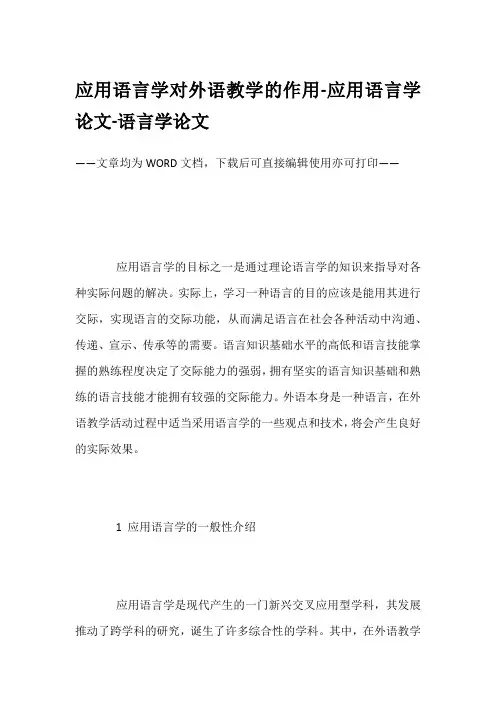
应用语言学对外语教学的作用-应用语言学论文-语言学论文——文章均为WORD文档,下载后可直接编辑使用亦可打印——应用语言学的目标之一是通过理论语言学的知识来指导对各种实际问题的解决。
实际上,学习一种语言的目的应该是能用其进行交际,实现语言的交际功能,从而满足语言在社会各种活动中沟通、传递、宣示、传承等的需要。
语言知识基础水平的高低和语言技能掌握的熟练程度决定了交际能力的强弱,拥有坚实的语言知识基础和熟练的语言技能才能拥有较强的交际能力。
外语本身是一种语言,在外语教学活动过程中适当采用语言学的一些观点和技术,将会产生良好的实际效果。
1 应用语言学的一般性介绍应用语言学是现代产生的一门新兴交叉应用型学科,其发展推动了跨学科的研究,诞生了许多综合性的学科。
其中,在外语教学的研究中,相关学科的理论和技术应用就已经受到了高度重视。
1)应用语言学的起源和理论应用语言学这个词最早是由一位俄罗斯语言学家在1870年提出的,但是在当时,应用语言学并没有引起学术界的关注,直到20世纪它才开始被建立,并作为一门的学科得到慢慢的发展。
到了19 年,应用语言学真正的学术地位得以确立,并在法国召开的第一届国际应用语言学学会上,国际应用语言学协会正式成立。
接着各国着名的语言学家纷纷出版语言学相关作品,此后,应用语言学开始蓬勃发展起来。
直到现在,应用语言学在西方的语言学里依旧是最热门的语言学研究领域之一,并且在语言学的众多分支中,它是发展最快的一门学科。
最开始,很多研究理论的人都认为应用语言学只是一种活动,并不具有什么可研究的理论价值,只是将理论研究出的成果付诸运用而已。
但是随着时间的推移,人们对应用语言学的研究越来越深入,建立应用语言学理论逐渐被学者们所认同,并被认为是十分必要的。
根据应用语言学的发展规律,在学者们连续几年的共同努力下,已经建立起了属于应用语言学自己的理论。
一些相关学者还认为应用语言学理论主要包括了心灵主义理论、错误分析理论和行为主义理论等。
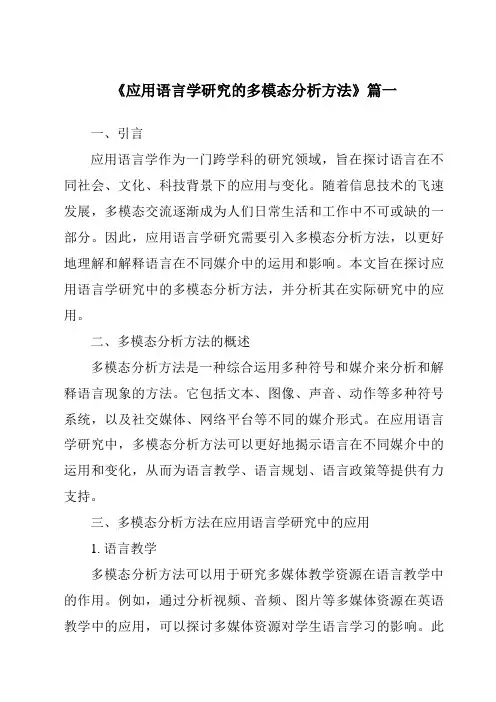
《应用语言学研究的多模态分析方法》篇一一、引言应用语言学作为一门跨学科的研究领域,旨在探讨语言在不同社会、文化、科技背景下的应用与变化。
随着信息技术的飞速发展,多模态交流逐渐成为人们日常生活和工作中不可或缺的一部分。
因此,应用语言学研究需要引入多模态分析方法,以更好地理解和解释语言在不同媒介中的运用和影响。
本文旨在探讨应用语言学研究中的多模态分析方法,并分析其在实际研究中的应用。
二、多模态分析方法的概述多模态分析方法是一种综合运用多种符号和媒介来分析和解释语言现象的方法。
它包括文本、图像、声音、动作等多种符号系统,以及社交媒体、网络平台等不同的媒介形式。
在应用语言学研究中,多模态分析方法可以更好地揭示语言在不同媒介中的运用和变化,从而为语言教学、语言规划、语言政策等提供有力支持。
三、多模态分析方法在应用语言学研究中的应用1. 语言教学多模态分析方法可以用于研究多媒体教学资源在语言教学中的作用。
例如,通过分析视频、音频、图片等多媒体资源在英语教学中的应用,可以探讨多媒体资源对学生语言学习的影响。
此外,多模态分析方法还可以用于研究不同文化背景下的语言教学策略,以帮助教师更好地适应不同学生的需求。
2. 语言规划与语言政策多模态分析方法可以用于研究语言规划与语言政策在不同社会、文化、科技背景下的实施效果。
例如,通过分析政府宣传片、广告等多媒体内容中的语言使用,可以了解政府在推广某种语言或方言时的策略和效果。
此外,多模态分析方法还可以用于研究不同社会群体对语言政策的态度和反应,以帮助政策制定者更好地制定和实施语言政策。
3. 跨文化交际多模态分析方法可以用于研究跨文化交际中的语言和非语言符号的运用。
例如,通过分析不同国家人们在社交媒体上的交流方式,可以探讨文化差异如何影响语言使用和非语言符号的解读。
此外,多模态分析方法还可以用于研究国际会议、商务谈判等跨文化交际活动中的语言和非语言符号的运用,以帮助人们更好地理解和适应不同文化背景下的交际需求。
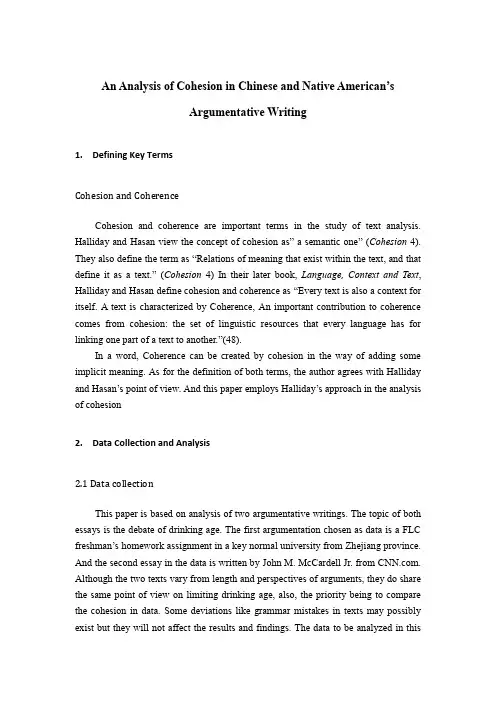
An Analysis of Cohesion in Chinese and Native American’sArgumentative Writing1.Defining Key TermsCohesion and CoherenceCohesion and coherence are important terms in the study of text analysis. Halliday and Hasan view the concept of cohesion as” a semantic one” (Cohesion 4). They also define the term as “Relations of meaning that exist within the text, and that define it as a text.”(Cohesion4) In their later book, Language, Context and Text, Halliday and Hasan define cohesion and coherence as “Every text is also a context for itself. A text is characterized by Coherence, An important contribution to coherence comes from cohesion: the set of linguistic resources that every language has for linking one part of a text to another.”(48).In a word, Coherence can be created by cohesion in the way of adding some implicit meaning. As for the definition of both terms, the author agrees with Halliday and Hasan’s point of view. And this paper employs Halliday’s approach in the analysis of cohesion2.Data Collection and Analysis2.1 Data collectionThis paper is based on analysis of two argumentative writings. The topic of both essays is the debate of drinking age. The first argumentation chosen as data is a FLC freshman’s homework assignment in a key normal university from Zhejiang province. And the second essay in the data is written by John M. McCardell Jr. from . Although the two texts vary from length and perspectives of arguments, they do share the same point of view on limiting drinking age, also, the priority being to compare the cohesion in data. Some deviations like grammar mistakes in texts may possibly exist but they will not affect the results and findings. The data to be analyzed in thispaper is in the appendix.The intentions of choosing and analyzing argumentative writing as data in this paper are as follows. Firstly, argumentative writing comprised a large portion of the writing part in Chinese high school English test. Secondly, correlation studies on this type of writing are rare. As a pre-service teacher, it would be beneficial for the author to study this writing type and employ the findings into future teaching career.2.2 Methods on data analysisThis paper employed Halliday’s categories of cohesion (Cohesion 333-339) to analyze data. The methodology of analysis is as follows:1.Identify the cohesive items in each sentence.2.Figure out the cohesion typepare the results in two texts and find differencesThe types of cohesion in data are showed in two tables in the part of results of analysis.3.Results and Discussion3.1 Results of analysisAfter the analysis of two texts, the author found that differences of cohesive items and types are obvious.Firstly, the cohesive items in text 1 are relatively diversified as different words and expressions like “it” and “that” are used to create text coherence. However, the cohesive items in text 2 are severely repeated, the items “you”and “I”make up a large part in total cohesive items of this text. Secondly, the richness in types of cohesion is different in two texts. The types are almost totally different in text 1 while the result is opposite in text 2. The monotonicity of cohesion types in text 2 may partly be related to the cohesive items. However, in text 2, the bonded sentences are mostly adjacent pairs and simple lexical repetition is used most frequently; in text 1, the bonded sentences for certain cohesive items are not adjacent. Thirdly, there is a significant difference between the two text s’ rate of using paraphrases. Expressions like “The statement” and “the answer” are used in text 1 in order to refer to longer sentences or the phrases in different parts of the text. However, text 2 lacks ofrichness in the usage of paraphrase.3.2 Reasons of cohesive distinctions between two essaysThe distinction of cohesive items and types are obvious after comparing the two tables. Reasons for the variation are to be discussed in following passages.Firstly, the cohesive items in two texts are varied. After close reading of text 2, the author found the defect is totally avoidable by replacing repeated words for cohesive items or lengthening sentences in the way of combining short sentences into longer ones. The monotonous of cohesive items and types are partly due to the Chinese ways of thinking as Chinese people view repetition as an aesthetic object of language. In addition, it is universal for an English word to have inflections and derivatives, which might contribute to the variation of cohesive items in text 1(native writer). However, Chinese writer (nonnative writer) may have troubles in dealing with that. The limitedness of vocabulary for Chinese writers affected their choice of words deeply.Secondly, the richness in types of cohesion is varied in two texts. Native speakers are skilled in making connections between what they are currently saying and what they said before and use different cohesive items to attain the aim, regardless of the distance of two bonded items. However, Chinese writer may lack the ability in doing that. He or she tends to think the whole passage in Chinese, and then interpret it into English when writing it down. It’s not easy for nonnative speakers to command the English way of logical thinking, still, thinking in English is essential for English learners to advance their English language ability.Thirdly, there is a significant difference between the two text s’ rate of usingparaphrases. The problem of monotonicity in cohesive items in text 2 can be avoided if writer use some paraphrases to replace the items like “I” and “you”. The reasons for this problem may come from the influence of mother tongue Chinese. It may also have something to do with writer’s vocabulary learning habits.3.2 Implications for teaching of EFL argumentative writingArgumentative writing is an important writing style for high school students to command and comprise a large proportion of writing tests. Generally speaking, there are three factors that influence students' writing ability: Logic thinking, language knowledge and writing skill. The results and analysis of cohesive problems accrued in Chinese student’s writing can be applied to argumentative writing teaching in high school. The implications for argumentative writing teaching are as follows.Firstly, it can be seen from the analysis that native writer tend to use far more complex cohesive items and fewer simple lexical repetition than Chinese student writings. This is caused by people's logical thinking, which is a very complicated factor. It mainly refers to student's life and studying background. Mostly, Chinese students are likely to translate their ideas from Chinese into English in the process of writing unconsciously. As a result, they tend to use the same words over and over again without the awareness of different cohesive devices. Therefore the number of cohesive items used in argumentative writing is limited. And most cohesive items used are of a monotonous type and lacking variety. Wherefore it’s important for teachers to focus on the coherence of discourse when teaching English writing. Some suggestions may be helpful: Teachers should pay attention to the coherence of passages in text books when giving reading classes. Reading and writing complement each other as the former emphasizes input and latter one focuses on output; Teachers can expose students to western cultures and try to train students the western ways of logical thinking if time permits. These trainings will also enhance students’ reading speed.Secondly, language knowledge is also a crucial fact for students to improve their argumentative writing. It mainly concerns about English vocabulary and grammar. Argumentative essay is relatively academic compared with other forms of writing as the words and phrases are mainly illustrative, not descriptive. In order to improve students’writing ability, teachers can hold debate competitions in class to enlarge students’ vocabulary for argumentative writing.Finally, writing skills or so called “the ability of d iscourse”is of great importance in teaching writing. Coherence ability determines whether students' writing is a good one. Consequently, in teaching writing skills, teachers should develop students' writing ability. Teachers can analyze the coherence of texts when explaining reading comprehensions and it can attract students’attention on the coherence of texts and focus on the issue when they write essays.For Chinese high school students, English cohesion is hard to attain as they are easily affected by mother tongue Chinese. So teachers should play an important role in constructing their knowledge in coherence and cohesion. (1653 words)ReferencesHalliday, M.A.K. & Hasan. Cohesion in English. London: Longman Group Limited, 1976Halliday, M.A.K. & Hasan. Language, Context and Text: Aspects of Language in a Social-semiotic Perspective. Melbourne: Deakin University Press, 1985 Johnstone, B. Discourse analysis (2nd ed.). Malden: Blackwell, 2008Nicholas, R. “Lexical cohesion in academic writing.”Modern English teacher23.1 (2014): 59-62胡壮麟.“有关语篇衔接理论多层次模式的思考”,《上海外国语大学学报》1996年第1期,第1-8页。
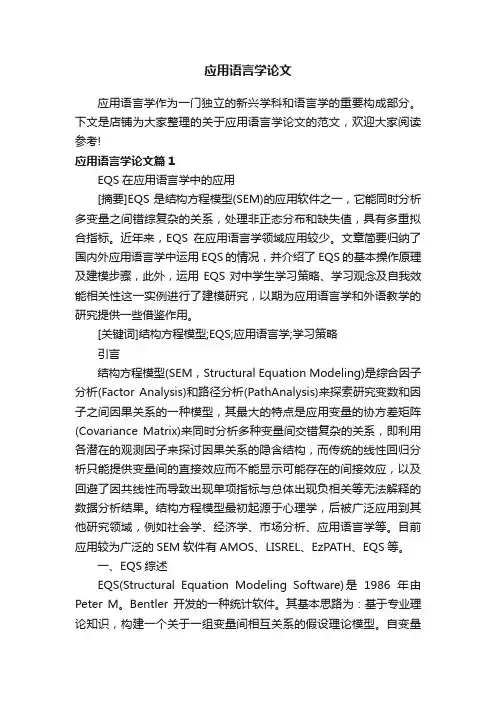
应用语言学论文应用语言学作为一门独立的新兴学科和语言学的重要构成部分。
下文是店铺为大家整理的关于应用语言学论文的范文,欢迎大家阅读参考!应用语言学论文篇1EQS在应用语言学中的应用[摘要]EQS是结构方程模型(SEM)的应用软件之一,它能同时分析多变量之间错综复杂的关系,处理非正态分布和缺失值,具有多重拟合指标。
近年来,EQS在应用语言学领域应用较少。
文章简要归纳了国内外应用语言学中运用EQS的情况,并介绍了EQS的基本操作原理及建模步骤,此外,运用EQS对中学生学习策略、学习观念及自我效能相关性这一实例进行了建模研究,以期为应用语言学和外语教学的研究提供一些借鉴作用。
[关键词]结构方程模型;EQS;应用语言学;学习策略引言结构方程模型(SEM,Structural Equation Modeling)是综合因子分析(Factor Analysis)和路径分析(PathAnalysis)来探索研究变数和因子之间因果关系的一种模型,其最大的特点是应用变量的协方差矩阵(Covariance Matrix)来同时分析多种变量间交错复杂的关系,即利用各潜在的观测因子来探讨因果关系的隐含结构,而传统的线性回归分析只能提供变量间的直接效应而不能显示可能存在的间接效应,以及回避了因共线性而导致出现单项指标与总体出现负相关等无法解释的数据分析结果。
结构方程模型最初起源于心理学,后被广泛应用到其他研究领域,例如社会学、经济学、市场分析、应用语言学等。
目前应用较为广泛的SEM软件有AMOS、LISREL、EzPATH、EQS等。
一、EQS综述EQS(Structural Equation Modeling Software)是1986年由Peter M。
Bentler开发的一种统计软件。
其基本思路为:基于专业理论知识,构建一个关于一组变量间相互关系的假设理论模型。
自变量数值通过测量所得,并形成一个自变量协方差矩阵,即样本矩阵。
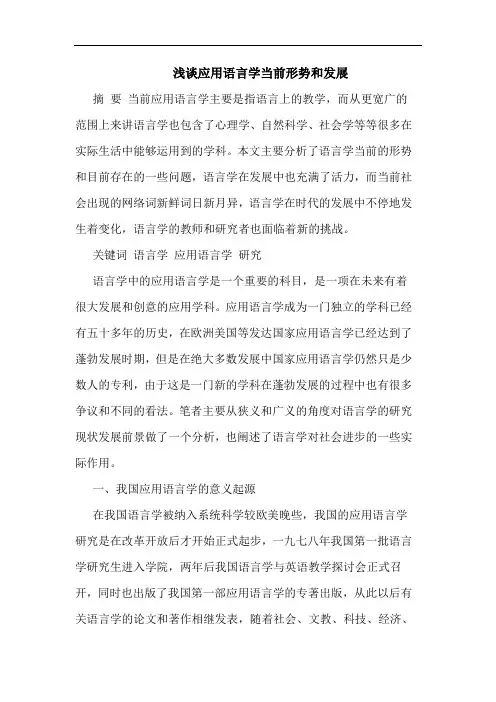
浅谈应用语言学当前形势和发展摘要当前应用语言学主要是指语言上的教学,而从更宽广的范围上来讲语言学也包含了心理学、自然科学、社会学等等很多在实际生活中能够运用到的学科。
本文主要分析了语言学当前的形势和目前存在的一些问题,语言学在发展中也充满了活力,而当前社会出现的网络词新鲜词日新月异,语言学在时代的发展中不停地发生着变化,语言学的教师和研究者也面临着新的挑战。
关键词语言学应用语言学研究语言学中的应用语言学是一个重要的科目,是一项在未来有着很大发展和创意的应用学科。
应用语言学成为一门独立的学科已经有五十多年的历史,在欧洲美国等发达国家应用语言学已经达到了蓬勃发展时期,但是在绝大多数发展中国家应用语言学仍然只是少数人的专利,由于这是一门新的学科在蓬勃发展的过程中也有很多争议和不同的看法。
笔者主要从狭义和广义的角度对语言学的研究现状发展前景做了一个分析,也阐述了语言学对社会进步的一些实际作用。
一、我国应用语言学的意义起源在我国语言学被纳入系统科学较欧美晚些,我国的应用语言学研究是在改革开放后才开始正式起步,一九七八年我国第一批语言学研究生进入学院,两年后我国语言学与英语教学探讨会正式召开,同时也出版了我国第一部应用语言学的专著出版,从此以后有关语言学的论文和著作相继发表,随着社会、文教、科技、经济、计算机、现代通讯设备、电子技术等走进生活中,语言的应用交际传递功能也得到了前所未有的扩大,应用语言学的研究范围也空前的广泛。
现阶段中语言学科同许多科目相交叉渗透,结合后又出现了许多边缘的学科,大家对应用语言学渐渐地也有了新的认识。
随着时间的推移语言学也有了较大的发展,当初的语言学在如今也发生了很大的变化,语言学现如今已经渗透到外语中去,目的是为了研究如何教授外语,这很符合当前实际的需求,也符合社会整体大发展的需要,也很符合语言学本身的发展规律。
二、语言学的当前的形势和未来的发展从语言本身的属性来说是为了人类沟通交流的一种工具,也是社会发展中所必不可少的一种工具,随着语言学这一系统科学研究的步步深入,应用语言学也开始得到很多人的关注,很多人也把目光都聚汇到这个新兴的研究领域,研究的范围也在逐步扩大当中,应用语言学是语言的一个科学,这样的属性决定了它有着无限的发展空间,语言学与其他各个学科在交叉渗透着,这也决定了语言学是属于一门综合性学科,而这种学科的认定又决定了应用语言学在实际人类生活中的必要性。

应用语言学论文题目语言学本科论文题目(一)1.浅谈英汉句子结构差异2.诗意的美和喜剧性幽默3.英汉禁忌语、委婉语的对比研究4.英汉数字习语的对比研究5.词义演变的原因与方式6.名词化的语篇功能7.诺曼时期法语对英语词汇的影响8.浅谈英语虚拟语气及其语用功能9.隐喻与一词多义的关系10.英汉被动句对比研究11.英汉宾语类型差异的认知原因12.英汉动词非谓语用法比较研究13.英汉否定问句的答句对比研究语言学本科论文题目(二)1.中英恭维语对比研究2.委婉语的礼貌原则研究及策略3.汉英“山丘”对比研究4.英汉颜色词跨域对比分析—以RED和红为例5.英语道歉方式的策略及研究6.英语拒绝言语行为研究7.英语委婉语的寒暄功能8.英语请求言语的策略研究9.英语课堂教师提问的策略研究10.会话得体:会话者的立场语境运用研究11.英语课堂学生提问的策略研究12.英语课堂的焦虑现象及策略研究13.从礼貌原则看短信语言14.从合作原则看课堂师生互动15.浅析中英言语行为中的礼貌原则16.中英政治新闻报道中的模糊语言研究17.言语错误分析理论在教学中的应用18.英汉颜色词的引申义的文化差别19.外语学习中应该重视中介语的作用20.浅谈英汉句子结构差异语言学本科论文题目(三)1.副词EVER的句法环境和语义特征2.论文化差异与英语教学中的文化导入3.学习者的动机因素对外语学习的影响4.浅谈词汇搭配错误分析及其应对策略5.浅析英语语言中的性别歧视现象6.礼貌原则在商务英语写作中的应用7.中英文性别歧视习语的对比研究8.称谓语使用中的性别差异9.从认知角度看隐喻在经济语篇中的应用10.论中英文化对隐喻的影响11.英汉合成词构词对比研究12.英汉名词短语修饰模式比较13.英汉拟声词异同探讨14.英汉人称代词运用对比研究15.英语复合词的语义分析及其类型16.英语委婉语的使用原则与策略17.语境对词义的制约作用。
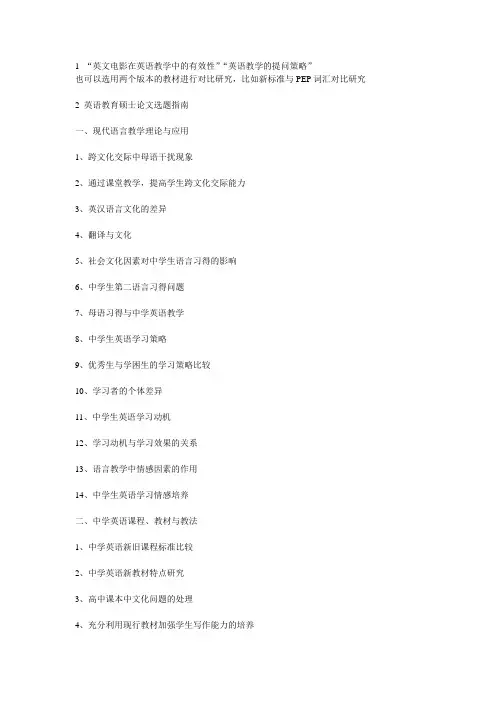
1 “英文电影在英语教学中的有效性”“英语教学的提问策略”也可以选用两个版本的教材进行对比研究,比如新标准与PEP词汇对比研究2 英语教育硕士论文选题指南一、现代语言教学理论与应用1、跨文化交际中母语干扰现象2、通过课堂教学,提高学生跨文化交际能力3、英汉语言文化的差异4、翻译与文化5、社会文化因素对中学生语言习得的影响6、中学生第二语言习得问题7、母语习得与中学英语教学8、中学生英语学习策略9、优秀生与学困生的学习策略比较10、学习者的个体差异11、中学生英语学习动机12、学习动机与学习效果的关系13、语言教学中情感因素的作用14、中学生英语学习情感培养二、中学英语课程、教材与教法1、中学英语新旧课程标准比较2、中学英语新教材特点研究3、高中课本中文化问题的处理4、充分利用现行教材加强学生写作能力的培养5、中学英语课程教学模式探索6、中学英语阅读教学模式研究7、中学英语语法教学模式研究8、高中英语教材语篇教学模式9、中学英语写作教学方法10、中学英语口语教学11、中学英语听力教学方法12、中学英语词汇教学研究13、中学英语阅读技能的培养与提高14、课堂小组互动与交际能力的培养15、高中英语交际策略与口语能力16、中学生听力能力的培养与提高17、中学英语课堂活动的基本特点18、中学英语课型设计和技能培养19、直观教学、绘画、简笔画等手段在中学英语教学中的应用20、英语课堂的设计21、教师语言习惯对学生的影响22、自由谈话在课堂教学中的应用23、课堂用语与学生思维能力的培养24、中学英语教学中文学知识的渗透25、中学英语教学与课外活动26、培养中学生英语自学能力27、中学英语教学中实践能力培养方案的探讨28、创造英语教学的真实语言环境策略29、教师教学策略研究30、英语教学与工具书使用31、中学英语目标教学32、中学英语素质教育目标33、中学素质教育与英语教育目标34、中学英语教学与德育教学35、本市中学英语教学现状的调查与分析36、中学英语师资现状和前景研究三、语言测试与评估1、语言测试理论与中学英语教学的关系2、语言测试的交际性3、英语测试如何适应素质教育的要求4、中、高考英语试卷分析与评估5、对中学英语教学测试中的误区之研究6、语言测试常见题型设计研究7、科学地解释考试分数8、中学英语课堂评估手段9、中学英语课外作业设计和评估10、英语课堂教学评估11、中学英语考试方法改革四、现代教育技术理论与应用1、多媒体技术在教学课件中的综合运用2、如何将网上最新资源引入中学课堂3、现代化教学手段在中学英语教学中的开发与应用4、中学英语教材多媒体课件研究5、运用多媒体,提高英语课堂教学效率6、多媒体技术在高中英语教学中的应用7、信息技术与英语教学3 语言学及应用语言学专业硕士论文答辩题目:汉语模糊限制策略研究答辩人:张鲁昌导师:宗世海副教授题目:汉语口语交际中异议表达的语用学研究答辩人:李静导师:宗世海副教授题目:汉语课堂话语模式分析及其教学启示答辩人:陈小英导师:李军教授题目:留学生实施汉语请求言语行为调查及习得研究答辩人:薛秋宁导师:李军教授答辩时间;6月11日上午9:00答辩地点:华文学院办公楼810欢迎光临!-------------------------------------------------------------------------------- 语言学及应用语言学专业硕士论文答辩题目:新加坡小学识字教学的改革问题及对策研究答辩人:黄茜导师:周健教授题目:新加坡“讲华语运动”研究答辩人:赵艳导师:郭熙教授题目:《灵山》语言艺术探讨答辩人:岳淑梅导师:曾毅平教授题目:新加坡小学奠基阶段华文教材课文选篇分析与比较——《小学华文》与《好儿童华文》答辩人:王佳琳导师:曾毅平教授答辩时间;6月12日上午8:30答辩地点:华文学院办公楼309欢迎光临!-------------------------------------------------------------------------------- 语言学及应用语言学专业硕士论文答辩题目:国际学校零起点至初级阶段学生华文教学的原则与方法答辩人:林素娥导师:彭小川教授题目:新加坡家庭教育对儿童华语的影响答辩人:李慈妃导师:李军教授题目:新加坡华文报纸平面广告的语言特点分析答辩人:谢粤导师:李军教授题目:新加坡学生华文学习兴趣的探讨及策略答辩人:范红导师:贾益民教授4 外国语言学及应用语言学专业研究生硕士学位论文答辩公告作者:wangy 时间:2009-5-31 8:39:17 来源:外国语学院点击:1093答辩人: 梁益论文题目: 新课程要求实施后5所高校124位公共英语专业教师信念的研究指导教师: 刘毅时间: 2009 年 6 月5 日9:00--9:30地点: 文科楼办公区1200会议室答辩人: 王磊论文题目: 对100名英语专业的大学英语学习者作文中连贯特征的研究指导教师: 齐放时间: 2009 年 6 月5 日9:30--10:00地点: 文科楼办公区1200会议室答辩人: 阳涌论文题目: 对布什和布莱尔就9/11事件演说的人际意义的对比分析指导教师: 齐放时间: 2009 年 6 月5 日10:00--10:30地点: 文科楼办公区1200会议室答辩人: 张晓来论文题目: 多媒体自主学习环境下,学习者的学习动机和策略与输入的互动研究指导教师: 齐放时间: 2009 年 6 月5 日10:30--11:00地点: 文科楼办公区1200会议室答辩人: 周娴玲论文题目: 学生译员的译前准备策略与口译质量指导教师: 张吉良时间: 2009 年 6 月5 日11:00--11:30地点: 文科楼办公区1200会议室答辩人: 朱立刚论文题目: 音段与声调在言语识别中作用对比的实验研究指导教师: 刘毅王红岩时间: 2009 年 6 月5 日11:30--12:00地点: 文科楼办公区1200会议室答辩人: 李丹论文题目: 英语专业高年级学生在交替传译中的语用失误指导教师: 张吉良时间: 2009 年 6 月5 日14:00--14:30地点: 文科楼办公区1200会议室答辩人: 何兴华论文题目: 英汉广告语中同音同形异义词的语用学研究--从关联理论的角度指导教师: 刘茁时间: 2009 年 6 月5 日14:30--15:00地点: 文科楼办公区1200会议室答辩人: 靳俊杰论文题目: 文学语篇中情感词汇的韵律结构研究指导教师: 金娜娜时间: 2009 年 6 月5 日15:00--15:30地点: 文科楼办公区1200会议室答辩人: 李建闯论文题目: 系统功能语言学的语法隐喻研究-- 英汉书评的个案研究指导教师: 尚媛媛时间: 2009 年 6 月5 日15:30--16:00地点: 文科楼办公区1200会议室答辩人: 刘林娟论文题目: CET4完型填空答题过程研究指导教师: 郭丽时间: 2009 年 6 月5 日16:00--16:30地点: 文科楼办公区1200会议室答辩人: 孙立华论文题目: 以小组合作促进自主学习的实证研究指导教师: 郭丽时间: 2009 年 6 月5 日16:30--17:00地点: 文科楼办公区1200会议室答辩人: 徐娅晖论文题目: 翻译与国族身份建构--后殖民主义视角下的鲁迅翻译活动指导教师: 李小均时间: 2009 年 6 月5 日17:00--17:30地点: 文科楼办公区1200会议室5 外国语言学及应用语言学专业硕士学位论文题目参考(2008-06-11 20:10:47)转载把部分题目收集起来,但缺少第一批答辩人员的题目。
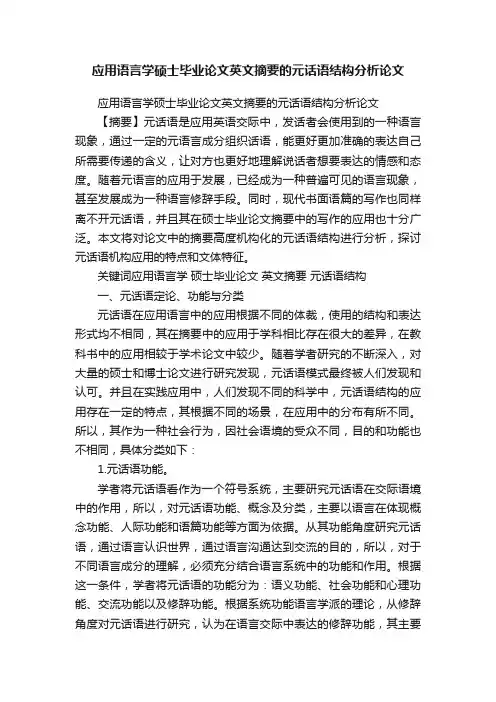
应用语言学硕士毕业论文英文摘要的元话语结构分析论文应用语言学硕士毕业论文英文摘要的元话语结构分析论文【摘要】元话语是应用英语交际中,发话者会使用到的一种语言现象,通过一定的元语言成分组织话语,能更好更加准确的表达自己所需要传递的含义,让对方也更好地理解说话者想要表达的情感和态度。
随着元语言的应用于发展,已经成为一种普遍可见的语言现象,甚至发展成为一种语言修辞手段。
同时,现代书面语篇的写作也同样离不开元话语,并且其在硕士毕业论文摘要中的写作的应用也十分广泛。
本文将对论文中的摘要高度机构化的元话语结构进行分析,探讨元话语机构应用的特点和文体特征。
关键词应用语言学硕士毕业论文英文摘要元话语结构一、元话语定论、功能与分类元话语在应用语言中的应用根据不同的体裁,使用的结构和表达形式均不相同,其在摘要中的应用于学科相比存在很大的差异,在教科书中的应用相较于学术论文中较少。
随着学者研究的不断深入,对大量的硕士和博士论文进行研究发现,元话语模式最终被人们发现和认可。
并且在实践应用中,人们发现不同的科学中,元话语结构的应用存在一定的特点,其根据不同的场景,在应用中的分布有所不同。
所以,其作为一种社会行为,因社会语境的受众不同,目的和功能也不相同,具体分类如下:1.元话语功能。
学者将元话语看作为一个符号系统,主要研究元话语在交际语境中的作用,所以,对元话语功能、概念及分类,主要以语言在体现概念功能、人际功能和语篇功能等方面为依据。
从其功能角度研究元话语,通过语言认识世界,通过语言沟通达到交流的目的,所以,对于不同语言成分的理解,必须充分结合语言系统中的功能和作用。
根据这一条件,学者将元话语的功能分为:语义功能、社会功能和心理功能、交流功能以及修辞功能。
根据系统功能语言学派的理论,从修辞角度对元话语进行研究,认为在语言交际中表达的修辞功能,其主要是传递信息、说服对方和传递情感。
在实际语言运用中言语发出者不仅要表达基础的话语层面意思,同时,还需要元话语层面上,使读者对实际交际内容做出反应,促使语言接受者组织、诠释、评价实际的交际内容。
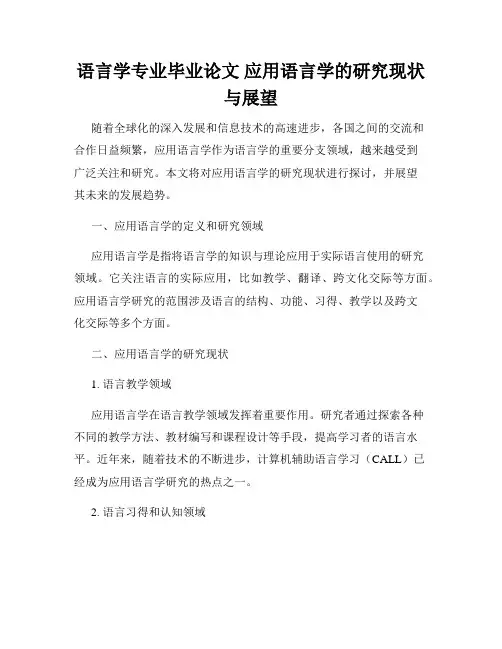
语言学专业毕业论文应用语言学的研究现状与展望随着全球化的深入发展和信息技术的高速进步,各国之间的交流和合作日益频繁,应用语言学作为语言学的重要分支领域,越来越受到广泛关注和研究。
本文将对应用语言学的研究现状进行探讨,并展望其未来的发展趋势。
一、应用语言学的定义和研究领域应用语言学是指将语言学的知识与理论应用于实际语言使用的研究领域。
它关注语言的实际应用,比如教学、翻译、跨文化交际等方面。
应用语言学研究的范围涉及语言的结构、功能、习得、教学以及跨文化交际等多个方面。
二、应用语言学的研究现状1. 语言教学领域应用语言学在语言教学领域发挥着重要作用。
研究者通过探索各种不同的教学方法、教材编写和课程设计等手段,提高学习者的语言水平。
近年来,随着技术的不断进步,计算机辅助语言学习(CALL)已经成为应用语言学研究的热点之一。
2. 语言习得和认知领域应用语言学对于语言习得和认知的研究也具有重要意义。
研究者通过探索语言习得过程中的认知机制、学习策略以及语言输入对习得的影响等问题,为语言教学、教材编写等提供理论依据。
3. 跨文化交际领域随着全球化的加深,跨文化交际成为应用语言学研究的另一个重要方向。
研究者通过分析不同文化背景下的语言差异和交际策略,帮助人们更好地进行跨文化交流和理解。
三、应用语言学的展望1. 多样化的语言教学方法未来,应用语言学将继续关注语言教学领域,努力推动语言教学方法的多样化发展。
通过整合新的技术手段和教学资源,例如虚拟现实、人工智能等,提升语言学习的效果。
2. 语言技术的发展随着信息技术的快速发展,自然语言处理技术成为应用语言学研究的新方向。
未来,语言技术将在机器翻译、语音识别、智能教育等领域发挥更大的作用。
3. 跨文化交际的研究随着全球化的深入发展,跨文化交际的需求越来越大。
未来,应用语言学将继续研究不同文化背景下的语言差异和交际策略,为人们提供更好的跨文化交际解决方案。
4. 可持续发展的教育模式未来,应用语言学将继续关注可持续发展的教育模式。
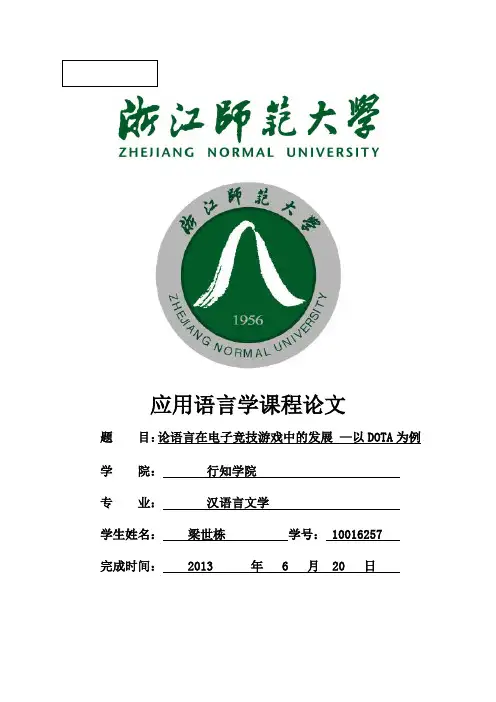
应用语言学课程论文题目:论语言在电子竞技游戏中的发展—以DOTA为例学院:行知学院专业:汉语言文学学生姓名:梁世栋学号:10016257完成时间:2013年 6 月 20 日论语言在电子竞技游戏中的发展——以DOTA为例时下在中国大学生圈子里,DOTA是公认的一款最热门的电子竞技游戏。
何为DOTA?笔者在这里稍微简单介绍一下:DOTA是一款即时战略对战的游戏,全称是Defense of the Ancients(缩写为DOTA),其翻译有守护古树、守护遗迹、远古遗迹守卫等。
Dota以对立的两个小队展开对战,通常是5v5,游戏目的是守护自己的远古遗迹(近卫方的世界之树、天灾方的冰封王座),同时摧毁对方的远古遗迹。
简单来说,就是守护己方基地,同时摧毁对方基地,得以取得游戏胜利。
话说人类的历史,就是一部战争的历史。
文明在战争中不断发展,不断变化,语言亦是如此。
在DOTA这款电子竞技游戏中,双方在同一张地图上你争我夺,勾心斗角,斗智斗勇,其险不输于赵子龙长坂坡在曹军中杀的七进七出,其智不亚于韩信咸阳”明修栈道,暗渡陈仓”。
以广大电竞爱好者的智慧跟创造力,我们的语言在其中到底会有怎样有趣并且出人意料的发展呢?且容笔者一一道来。
开黑:开黑,也就是“开黑店”的简称。
黑店:旧时指杀人越货的客店,今指骗人、敲诈的商店。
《绿牡丹第十二回花振芳救友下定兴》:“我差人相随亦非徒备路费,黄河这边皆山东地方,黄河相近,路多响马,黑店甚多。
我差人送去,方保无事。
”《儿女英雄传》第七回:“原来外间穷山僻壤,有等惯劫客商的黑店合不守清规的庙宇,多有在那卧牀后边供桌底下设着地窨子,或是安着地道。
”在DOTA中,黑店指的是一群相互认识、交流方便的人组成一队进行游戏的行为,由于他们能够方便的进行交流,因此能够打出较好的配合,而且会默契的选择一些很占优势的英雄组合,如果对面都是互相不认识的路人的话,这是占有很大的优势的。
现在很多黑店不是五人黑,一般配合娴熟的两人以上就称为黑,如两人黑,三人黑,四人黑以及五人黑。
应用语言学研究现状及学科建设思考论文应用语言学研究现状及学科建设思考论文摘要:人生不可或缺的元素是语言。
在历史上,很多文献我们做了非常深入的分析研究。
作为日常生活中非常重要的象征性通信系统的人类语言,其本身的价值在于内部使用的实践和功能。
因此,应用语言学正在与社会发展相融合。
本文将主要从其研究现状和学科建设两个方面进行分析,旨在不断增强人们对应用语言学的认识,加快中国应用语言学发展的步伐。
关键词:应用语言学;学科建设;课程设置作为语言学的重要组成部分,应用语言学已成为语言圈的重要学科之一,具有重大的创新意义和巨大的发展前景。
我国把应用语言学作为独立学科发展,是在上个世纪60年代。
我国距美国、英国等发达国家的应用语言学仍然存在很大距离。
但作为一个自身就有很强生命力的学科,应用语言学有很大的发展空间,有发展空间就会有很多议论,人们对它的研究方法,发展方向,性质等诸多问题存在不同的看法和理解。
本文将主要从其研究现状和学科建设两个方面进行分析,旨在不断增强人们对应用语言学的认识,加快中国应用语言学发展的步伐。
一应用语言学的定义和研究范畴(一)应用语言学的定义应用语言学是一门由多边缘学科交叉组成,在现实生活中为人们解决各种语言问题和语言教学问题。
我们的学者长期以来一直关心这个问题,基于交际语言学理论是建立和语言学科,进一步完善理论体系,是语言学习方法,原理与一般法律。
应用语言学的最终目标是指导语言在社会实践中的应用,满足不同领域的发展需要。
应用语言学是一门新学科,独立于其他学科,涉及范围广泛的不同领域。
应用语言学研究主要针对语言教学,规划,语言本体论,学科建设和广义社会语言学等方面。
应用语言学独立于其他学科,但与其他新兴学科相互关联,所以在这一点上应用语言学有一定的扩展。
(二)研究范畴应用语言学包括一些语言学科,不仅仅是心理语言学和社会语言学等。
社会语言学的范围主要是社会和语言关系,在应用和区分理论中,我们也可以被称为社会语言学或社会语言学的应用。
华中科技大学硕士学位论文现代汉语双宾语句结构浅析姓名:危艳丽申请学位级别:硕士专业:语言学及应用语言学指导教师:邹哲承20061105华中科技大学硕士学位论文摘要双宾句是语法学家们普遍注意到一个句法类型,关于双宾句的话题是常谈常新。
本文在前人研究的基础上,以对内具有统一性,对外要有排它性为标准,在第二部分规范了双宾句的基本格式,将变式(“把”字句和与格句)、宾语同位句以及“动宾式+宾语”组合结构和双宾句区分开来。
第三部分,论述了双宾句的句法性质和认知意义。
双宾语句和三价动词有着密切不可分割的关系,只有弄清两者之间的关系才能进一步了解双宾句的句法性质。
经分析后,我们发现双宾句是三价动词和其所必需的三个语义成分一起构成的一种特殊句式,但结构比由三价动词形成的其它句式更为紧凑。
因为不是所有的三价动词都能进入双宾句中,而且三价动词和双宾句式属于不同的语法范畴,所以双宾动词不是三价动词或者双及物动词。
然后,本文在对给予式双宾句和与格格式、表称双宾句和表称动词构成的兼语句、索取类双宾句式和索取类单纯动宾结构进行比较后,在分析了双宾句的形成动因后,总结出双宾句的句法意义:双宾句是从说话人的主观视点来考虑的,表示单一行为和单一过程,并将行为过程发生的三个必不可少的语义成分完整精确地表达出来的一种句式。
第四部分,从取得类动词和领属关系的特殊性两个方面,谈领属关系和双宾句的关系。
取得类动词的语义是施动者取得对直接宾语的领有权,那么具有[人事]特征的间接宾语和直接宾语的关系只能是领属关系。
可转让领属关系最大的特点是,转让领属过程需要三个必要元素:施者(得者)、受者(损者)、转移物,而双宾句可以将三个必要元素紧密地结合在一起。
第五部分,论述了二价动词是怎样进入双宾句的,哪些二价动词可以进入双宾句。
动词的配价并不能决定句式的语义成分数量出现的多少,句式可以临时决定动词的配价,这给二价动词进入双宾句提供了很大的机会。
第六部分,认为双宾句应该三分,只有结构层次三分才能体现双宾句的句法结构和语法意义。
期末论文题目:Analysis on Grammar-Translation Method 所在学院:外国语学院专业:学科教学英语学号:2016281020066作者姓名:谭立力任课教师:汪火焰2017年1 月15 日OUTLINEAbstractKey wordsI. Brief Introduction on Grammar-Translation MethodII. The Advantages of Grammar-Translation MethodIII. The Definition of Grammar and the Relationship Between Grammatical Competence and Communicative Competence.IV. The Revaluation of Grammar-Translation MethodV. ConclusionBibliography中文标题、摘要、关键词Analysis on Grammar-Translation MethodAuthor: Tan Lili Number:2016281020066 Course Name: Applied Linguistics Abstract: Grammar-Translation Method was the major teaching method of foreign language teaching in China. However, it has been impacted and challenged by the emergence of teaching approaches, such as Communicative Language Teaching, Natural Approach and Audio-Lingual method. This paper introduces the teaching status of grammar teaching and discusses its necessity and possibility from three aspects: the nature of grammar, the relationship between grammatical competence and communicative competence, the disadvantages of traditional grammar teaching and its development trend.Key Words: grammar-translation method; advantages and disadvantagesI. Brief Introduction on Grammar-Translation MethodGrammar-Translation Method, which developed more than 1,000 years ago and thrived in 1940s, is the oldest of all language teaching methods. Later, the development of linguistics and psychology formed a theoretical and scientific foundation for Grammar-Translation Method, making it the main method of language teaching and learning until 1960s. Before 1970s, China had cultivated, mainly through Grammar-Translation Method, a large group of English workers and technical personnel with a good command of English. During the Middle Ages, this method was adopted to help people to read the literature written in Latin. In the 18th and 19th century, people used it to teach English and French, thus forming a complete teaching system. In the beginning, people learned language to read and translate Greek and Latin books. It was therefore necessary and effective to carry out teaching with the help of mother tongue and learn these two languages by translation. It conforms, to a large degree, to the objective law under which people understand and learn a foreign language, and enables learners to grasp its grammar system. The study of linguistics also provides the theoretical basis for Grammar-Translation Method. Linguistics refers to the study of language in general and of particular languages, their structure, grammar, and history, therefore providing scientific methods for language teaching. In the 18th century, the study and classification of vocabulary by linguists was of great importance to the development of this method. It is these grammatical terms and division of words that we have always relied on to analyze and explain the text. Linguists also believe that learners should master a foreign languagethrough studying written language, which defines the corresponding categories for the content of this method. Grammar is regarded as an adhesive, through which language learners can express their thought and then master it. As a result, it is seen as the core content of language teaching. Besides, in language learning and teaching, psychology pays more attention to language learners and users. According to Chomsky’s generativism, mankind has an innate ability to form certain concepts, and concept formation is a prerequisite for human’s acquisition of the meanings of words. Generativism is, therefore, in favor of the application of Grammar-Translation Method in language teaching. We can say that its appearance benefits from the linguists’ knowledge of language and the social needs at that time. The principal characteristics of this method were these:1.The purpose of foreign language study is to learn a language in order to read its literature. It stresses students’mental discipline and intellectual development that result from foreign-language study. Students are required to improve their reading skill by reading original work.2.Reading and writing are the major focus; little or no systematic attention is paid to speaking or listening.3.Grammar is taught deductively; and the sentence is the basic unit of teaching and language practice; accuracy is emphasized.People gradually found out the disadvantages of this method after the Second World War, during which there was a huge demand for people who can speak foreign language, students trained by this method cannot meet the needs of the times, generative linguistics became the mainstream of linguistic theory by replacing structural linguistics, and the emergence of cognitivism in psychology led to considerable development in people’s cognitive ability.Communicative Approach and Natural Method dominated linguistics after 1970s, with Grammar-Translation Method faced with severe challenge and almost being abandoned. These theories held that language teaching requires no explanation and language study is not a process of reasoning but a result of people’s inner natural ability under certain circumstance, that language study involves practical conversation. According to Communicative Approach based on the theory of functional linguistics, the purpose of language teaching is to cultivate students’ communicative competence rather than to merelyteach grammar and vocabulary. According to Audio-Lingual Method based on the theory of structural linguistics, learners do not need to understand grammatical rules, for language study is a process of forming habits and the study of sentence structures. It focuses on accuracy through drill and practice in the basic structures and sentence patterns of the target language. Natural Method rejects the formal grammatical organization of language as a prerequisite to teaching and that a focus on comprehension and meaningful communication as well as the provision of the right kinds of comprehensible input provide the necessary and sufficient conditions for successful classroom second and foreign language acquisition . It holds with Newmark and Reibel that “an adult can effectively be taught by grammatically unordered materials”.Influenced by the language teaching pattern of former Soviet union in 1950s and 1960s, China has adopted Grammar-Translation Method as its main teaching method until the early 1980. With the deepening of Chian’s reform and opening up, there existed many foreign linguistic theories and teaching methods and an increasing demand for improving students’ communicative competence. As a result, Grammar-Translation Method gradually dropped out of its mainstream position in language teaching. In various English textbooks published over the past few years, the proportion of grammar is decreasing year by year. In addition, grammar only accounts for ten per cent in all kinds of English examinations. It seems that grammatical competence is opposed to communicative competence, and that grammar teaching has become a dispensable part in language teaching and even become an obstacle to the development of students’ communicative competence.II. The Advantages of Grammar-Translation Method1.It focuses on grammar teaching, combined with vocabulary analysis and abundant translation practice, to train students’ reading and translation ability. The grammar analysis is made in order of difficulty, which well reflects the essential function of language acquisition. Let’s take skill-learning model as an example. Skill-learning-model, from the angel of behaviorism and cognitive development, emphasizes that learners should use exercises to achieve the anticipated purpose, mastering a language. The acquisition of a certain skill entails the integration of skill training of its parts, which is decided by the order in which we use langue. That is to say, the more information---grammar, vocabulary,and syntactic structures---- a language learner gets at the preliminary stage of learning, the more initiative he will have to achieve his higher aim. We can therefore say that it is an effective way to learn a second language through the study of grammar and vocabulary.2.From the perspective of teaching content, it requires students to grasp grammatical rules, vocabulary and sentence structures through a considerable amount of translation practice. This instruction form embodies the student-centered class teaching model in which students, by utilizing the grammatical rules their teachers taught, conduct translation and bilingual conversation so as to be clear about the differences and similarities between their mother tongue and target language and strengthen their understanding of it.3.The characteristics of this method also puts forward a high request to the teachers’and students’language ability. First, only when teachers have a better understanding of both mother tongue and target language , can they impart to their students grammatical knowledge and language structural system and make a judgment about their translation. Second, only when students memorize and recite grammatical rules, can they guarantee the quality of language output. In this way, both students and teachers study and memorize grammatical rules, and grasp the target language through lots of translation exercise.Ⅲ. The Definition of Grammar and the Relationship Between Grammatical Competence and Communicative Competence.In linguistics, grammar is the set of structural rules governing the composition of clauses, phrases, and words in any given natural language. The term refers also to the study of such rules, and this field includes morphology, syntax and phonology, often complemented by phonetics, semantics, and pragmatics. There are several instances. According to Longman Dictionary of Contemporary English written by Paul Procter, grammar refers to the rules by which words change their forms and are combined into sentences. In Crystal’s A First Dictionary of Linguistics and Phonetics, grammar refers to the way words and their component parts, combine to form sentences. These two definitions are limited, but they tell us that grammar is indispensable to correct sentence making. Bowen pointed out that grammar refers to the rules by which we combine meaningful words and phrases into sentences for the communication and the understanding of information. Bowen’s explanation is more precise. Using grammar to make sentencescannot be restricted to its forms and separated from certain meanings, for a sentence , cut off from practical environment, will not produce any meaning. Some scientists, however, enlarge the definition of grammar. Gribbin, for instance, divides grammar into three parts: the unconscious knowledge of language, the conscious knowledge of language, and language rules and usage.There is no doubt that the ultimate purpose of language teaching is to cultivate students’ability to put what he has learned into practical communication, namely, communicative competence. Then the question we should be specific about is whether grammar teaching is opposed to the cultivation of communicative competence. Linguistic competence consists generally of two parts: language knowledge ( pronunciation, vocabulary, and sentence ) and language ability ( listening, speaking, reading, and writing ), of which grammatical competence is the most important part. Communicative competence refers to the ability to achieve a certain communicative aim by a combination of language and non-language ( gestures and facial expressions ) approaches. It generally includes sociolinguistic competence, strategic competence and discourse competence. Language learning should follow three principles: grammatical principle, communicative principle and cultural principle. As linguistic competence is an important condition for the development of communicative competence, and grammatical competence is an important part of linguistic competence, it can be seen that grammatical competence is the most important part of communicative competence. Once grammar teaching is conducted in an appropriate way, it will act as a catalyst for the improvement of communicative competence. And poor grammatical competence will absolutely have a negative impact on the cultivation of communicative competence.We can draw a conclusion from the above discussion that they are not opposed but complementary to each other. What Grammar-Translation Method emphasizes is rational knowledge and rules, grammar, translation and contrast, mother tongue, and language knowledge, without paying much attention to language skills. Communicative Method, taking linguistic function as the key link, centers on pragmatic communication rather than grammar. That is to say, “Fluency is superior to correctness” and “Teaching language rather than teaching knowledge about language”. Grammar-Translation Method can make up for the deficiency of Communicative Method and Audio-Lingual Method in training learners’reading and grammar competence. Communicative Method can in turn remedy the defect of Grammar-Translation Method in practical use. In the middle and later periods of language learning, students, equipped with a certain amount of language knowledge, can reinforce what they have learned and improve their ability in using the language with the help of Communicative Method. However, it does not mean that Grammar-Translation Method should be discarded, since it still plays an essential role in the analysis of long and difficult sentences.IV. The Revaluation of Grammar-Translation MethodIt is undeniable that there are lots of defects in traditional grammar teaching. Without modification and improvement, it would be hard to adapt to the need of our age and to be revitalized. Grammar-Translation Method, with its undiversified teaching means and process, overemphasizes translation exercise and ignores the training of speaking and listening. The analysis of language materials without certain discourse makes the students only focus on the rational analysis of syntax and `impedes the development of students’listening and speaking skill. What students have learned is merely the boring concepts and rules. As they do not have enough opportunity to be exposed to various language forms, these rules and concepts acquired can hardly turn into unconscious knowledge and skill and thus practical communication is beset with difficulties. That is the main reason why at present our country commonly exists the problem of dumb English in foreign language teaching.Despite the deficiencies in traditional language teaching, it does not mean that grammar teaching is unimportant. On the contrary, grammar has always been and will undoubtedly be an important part of language learning.Grammar-Translation Method is the basis of various teaching methods. As it is has been around for a long time, it will inevitably be criticized when there appears other new teaching approaches and methods. Grammar translation emphasizes the study of basic language knowledge. Only by mastering a certain amount of language knowledge and rules, can we carry out imitation training and then develop the ability in using language. Translation plays an important role in language teaching. First, translation can help learners make clear the structure and system of their mother tongue and target language, revealing the corresponding relationship between their forms; Second, in the process of comparingtwo languages, translation can enable us to discover their difference. Language is systematic, and its systematicness is to a large degree reflected in its grammatical structures. Grammar and vocabulary are the sources of communication. Without a deep understanding of the words, and without a fine grasp of grammar rules, the cultivation of communicative competence would become water without source.Grammar-Translation method is an effective way to achieve other teaching methods. It can effectively resolve the difficulties in language teaching, help students accurately grasp the characteristics and differences of two languages. As the famous linguist F. G. French once said, grammatical points should be explained in native language. It is therefore useful to compare English grammatical points with those of Chinese. He added that it would be difficult to explain some words clearly without the help of translation. Grammar -Translation method also helps to improve students’ interest in learning English, enhance their learning motivation, and to a certain degree reduce their learning anxiety and stress. The epiphany about the subtle differences between different languages will enable students to produce a strong sense of self-realization and trigger a strong interest in foreign language learning.Grammar and translation are also one of the ultimate aims of language teaching. The study and mastery of grammatical knowledge will help learners analyze and comprehend English articles and information. Among the five skills, translation is a most complex and high-valued one. It is both a process and a purpose ---to some extent a very important purpose---of foreign language learning. It helps learners to learn and understand new knowledge and enables them help others to learn new knowledge. It is a reliable way of language examination. It is even an important means of improving oral ability. The translation method plays an indispensable role in cultivating students' reading and writing ability.When utilizing a teaching method, we should consider its scientificity and probability and related restricting factors, such as student source, teaching staff, language environment and teaching condition. The improvement of the learners’ ability in using English must be based on the understanding and use of written language. What language teaching aims at is to help students learn English rather than study English. Therefore, several suggestions are were put forward:1. Much attention should be paid to the training of basic language skills in fundamental stage. Language teaching should be organized and carried out according to the ideas and methods of Grammar-Translation Method. If students have not mastered the basic grammatical knowledge of English, whenever they speak, they feel that they always get stuck and that grammar keeps them from going on smoothly. To express thoughts and feelings in fluent English, the accuracy of language structure is of extreme importance. Therefore, great importance should be attached to the explanation and exercise of core vocabulary, basic sentence structures and grammatical points to help students possess proficient language basis.2. Students should be encouraged to use and practice English. Class teaching should be organized according to the strategies and means of Communicative Method. Teachers must realize that Grammar-Translation Method and Communicative Method are not contradictory but compatible. Communicative competence consists of linguistic competence, and the former is built on the latter. Thus, we should emphasize the correctness and fluency of language and its appropriateness as well. In class teaching, teachers should reexamine their roles, and play fully their mediation role in order to make students actively participate in classroom activities, to encourage them to use what they have learned and speak English as much as possible.3. Much attention should be paid to language input. Reading and reciting play a crucial role in language teaching. Language learning is a process of habit formation, and reciting is an effective way to form good language habits. Reciting is based on the clear understanding of vocabulary, grammar and structure of an article. During the reciting, students should be encouraged to read loud. With a fine grasp of grammatical knowledge and a large vocabulary, students can effectively improve their ability in listening, speaking and writing.V. ConclusionThe appearance of Communicative Method had the impacts and challenges on the survival of Grammar-Translation Method raises quite higher requirements to language teaching. Traditional grammar teaching, with its focus only on language forms, can no longer meet the needs of current language teaching, and grammar reaching reform must beenforced. The key problem is not whether grammar should be taught, but how we combine grammar teaching with the communicative aim of language teaching. Grammar should play its full part in the language teaching. Despite its defects, Grammar-Translation Method is still indispensable in the language teaching.Bibliography[1]Paul Procter. Longman Dictionary of Contemporary English [M]. London: PitmanPress, 1978: 494.[2]Crystal, D.A First Dictionary and Linguistics[M]. London: Andre Dentsch, 1986:494.[3]Gribbin. The Role of Generalization in Studying Grammar and Usage[J]. EnglishJournal, 1966: 55-56.[4]H. H. Stem. Fundamental Concepts of Language Teaching [M]. Shanghai ForeignLanguage Teaching Press, 1997: 126-452.[5]Jack C. Richards and Theodore S. Rodgers. Approaches and Methods in LanguageTeaching [M]. Foreign Language Teaching and Research Press, 2000.[6]郝兴跃. 再论语法在外语教学中的作用[J]. 云南师范大学学报, 2003(5): 4-5.[7]桂诗春. 运用语言学[M]. 湖南教育出版社, 1998.[8]张谦中. 国外外语教学法主要流派[M] .华东师范大学出版社, 1983.11。
有关语言学的论文论文常用来指进行各个学术领域的研究和描述学术研究成果的文章,它既是探讨问题进行学术研究的一种手段,又是描述学术研究成果进行学术交流的一种工具。
论文一般由题名、作者、摘要、关键词、正文、参考文献和附录等部分组成。
论文在形式上是属于议论文的,但它与一般议论文不同,它必须是有自己的理论系统的,应对大量的事实、材料进行分析、研究,使感性认识上升到理性认识。
有关语言学的论文1随着社会的不断进步与发展,当前汉语言文学教学的现状不容乐观,存在教学模式因循守旧、教学方法和教学手段单一、教师综合素质不高等问题,严重影响了汉语言文学教学作用的发挥。
一、汉语言文学教学现状1、教学模式因循守旧在汉语言文学的教学中,许多学校的教师仍采用灌输式的教学方式,使学生被动地接受知识,导致“教”与“学”的效率难以提高。
久而久之,在枯燥、乏味的课堂教学中,学生学习的积极性和主动性被逐步削弱,甚至出现厌学情绪。
2、教学方法和教学手段单一以往教师在进行汉语言文学教学时,基本采用的都是填鸭式的教学方法。
由于教学方法过于单一,从而严重影响了学生学习汉语言文学的兴趣,致使教学效果不理想,加之教学中欠缺现代化教学手段的运用,教学质量一般。
3、教师综合素质有待于提高由于汉语言文学教师在实际教学过程中语言魅力的缺失,致使课堂气氛过于沉闷,从而使得学生配合教学的积极性较差,思维也被严重抑制。
在这一过程中,教材成了束缚学生自由发挥想象力的枷锁,诸多的语法、课文、词汇、阅读和写作等课程,使学生对汉语言学习产生出一种乏味和厌烦的感觉,这样必然会使教学效果大打折扣。
究其根本原因主要是由于教师的综合素质不高造成的。
为此,必须不断提高汉语言文学教师的综合素质。
二、汉语言文学教学改革的策略1、完善课程结构应按照社会发展对人才的要求,加大汉语言文学选修课的比重,并在为学生打下扎实专业功底的基础上,不断延伸、拓展学科范围,将一些与之相关专业的知识融入到汉语言文学教学内容当中,如哲学、史学、新闻学、公共关系学、美学、艺术、秘书学、国学以及影视等等。
应用语言学硕士论文结论语步的互动式元话语研究”王银铃王秀文(南京航空航天大学外国语学院)摘要:近年来,学术语篇的研究往往从功能语法视角或从体裁分析的单一角度进行,二者相结合的实证性研究不多见。
因此,本文以2014—2018年知网上50篇应用语言学硕士实证类学位论文的结论部分为研究对象,自建语料库,结合语步结构考察结论中互动式元话语的特征。
研究发现,结论部分写作中有以下三个特点:(1)互动式元话语少于交互式元话语。
(2)结论各语步下过度使用增强语和过少使用介入标记语和自称语。
(3)!总结研究”和“评价研究”语步都倾向于使用增强语,“研究启示”语步倾向于使用模糊语,且“总结研究”语步下模糊语和增强语使用不平衡。
本研究的发现将有助于规范中国二语学习者学位论文结论部分的写作及相关二语写作教学。
关键词:硕士学位论文;结论部分;语步;互动式元话语0.引言学术论文的目的是展示学者最新的发现和研究成果。
在学术论文中,结论部分恰恰是所有发现和结果集中展示的地方。
因此,写好学术论文的结论部分对二语学习者来说有着重要意义。
然而,当前中国二语学习者在结论部分的写作中存在很多问题。
例如:学术论文结论中,互动式元话语使用不足,导致论文缺乏人际互动。
并且结论部分没有遵循相应的语步,造成逻辑混乱,从而影响作者观点的传递和交流。
对于二语学习者学术论文结论章节中存在的写作问题,学者们往往从两个视角开展研究一语篇内在微观层面的元话语研究和语篇宏观建构的体裁分析。
例如:吴格奇(2010)从元话语视角讨论了中国学者期刊论文结论章节中立场标记语的使用。
在体裁分析方面,刘卉(2011)发现自建语料库(应用语言学的英语期刊论文结论部分)中没有哪一篇论文包括全部语步。
针对相关研究发现,Amnuai和Wanna-ruk(2013)在对比了本族语学者和泰国学者期刊论文结论的语步分布后,对泰国学者结论章节的语步使用特征以及背后深层的文化差异做出了解释。
《应用语言学研究的多模态分析方法》篇一一、引言应用语言学作为一门跨学科的领域,旨在探讨语言在不同社会、文化、科技背景下的应用及其影响。
随着信息技术的飞速发展,多模态交流已经成为日常生活和学术研究中的常见现象。
因此,多模态分析方法在应用语言学研究中的重要性日益凸显。
本文将探讨应用语言学研究的多模态分析方法,并对其在语言教学、语言传播和语言理解等方面的应用进行深入分析。
二、多模态分析方法概述多模态分析方法是一种综合运用多种符号、图像、声音等元素进行信息传递和交流的分析方法。
在应用语言学研究中,多模态分析方法主要关注语言与其他符号系统的互动关系,如文字、图像、声音、动作等。
这些符号系统共同构成了多模态话语,为人们提供了丰富的信息资源和交流方式。
三、多模态分析方法在语言教学中的应用1. 多媒体教学资源:多模态分析方法可以充分利用多媒体教学资源,如视频、音频、图片等,为语言教学提供丰富的教学材料。
这些多媒体资源可以帮助学生更好地理解和掌握语言知识,提高学习效果。
2. 互动式教学:多模态分析方法强调师生之间的互动和交流。
通过运用多种模态,教师可以引导学生积极参与课堂讨论,提高学生的语言表达能力和交际能力。
3. 跨文化交际:多模态分析方法有助于学生理解和适应不同文化背景下的交际方式。
通过分析不同文化中的多模态话语,学生可以更好地掌握跨文化交际的技巧和策略。
四、多模态分析方法在语言传播中的应用1. 媒体语言分析:多模态分析方法可以对媒体语言进行深入分析,揭示媒体语言的特点和规律。
这有助于我们更好地理解媒体对语言传播的影响,提高媒体语言的质量和效果。
2. 网络语言研究:随着网络的发展,网络语言已经成为一种重要的语言现象。
多模态分析方法可以对网络语言进行多角度、多层次的分析,揭示网络语言的特性和规律。
3. 广告语言分析:广告语言是一种典型的多模态话语。
通过运用多模态分析方法,我们可以深入分析广告语言中的文字、图像、声音等元素,揭示广告语言的传播策略和效果。
成绩大连外国语大学应用语言学基础学期论文任课教师研究方向英语词汇记忆策略年级专业姓名学号完成日期非英语专业研究生英语词汇记忆策略的实证研究摘要在二语习得中,词汇对于语言学习者有着异乎寻常的重要性,词汇是一切语言技能的基础。
探索并总结积极有效的词汇记忆策略,是减轻学生负担、培养学生英语学习兴趣、提高英语学习成绩的有效途径。
过去 20 年里,许多专家和学者做了大量的研究工作,在他们的共同努力下,英语词汇学习策略的研究有了显著的进步,也取得了很大的成绩。
大量事实已证明:掌握数量可观、记忆牢固的词汇是英语学习成功的关键。
一些学者对优秀学生的词汇学习策略进行了研究;另一些学者研究了一定群体学习者的词汇学习策略;还有的学者研究了不同性别的学习者的词汇学习策略的使用情况。
然而,以非英语专业研究生的英语词汇学习策略为研究对象的却不多。
这篇文章在回顾了国内外词汇学习策略的研究现状之后,主要以大连外国语大学非英语专业一年级的研究生为研究对象,探索了他们英语词汇记忆策略使用情况,旨在了解非英语专业研究生使用英语词汇记忆策略的情况,证明词汇学习策略训练对高一学生的英语词汇学习有积极的促进作用。
本文通过问卷调查和教学实验,试图回答以下问题:1)学生目前的英语词汇记忆策略使用现状如何?2)词汇策略训练能否提高学生词汇水平?是否有促进作用?研究结果表明:有效的词汇记忆策略能改善学生的英语学习状况,并提高其英语成绩。
非英语专业研究生常用的英语词汇学策略有很多,如构词记忆法;拼读策略;词汇表策略;语境策略;查字典策略;分类记忆策略;元认知策略等,并且使用多种词汇记忆策略的效果明显优于少量策略,掌握越多的策略越容易扩大学生的词汇记忆量。
关键词:词汇记忆策略,非英语专业研究生,AbstractIn the Second Language Acquisition, vocabulary is of great importance to language learners and also it is the basis of other language skills. Concluding effective memory strategies is the effective way to reduce the burden of English learners and to improve the education quality. In the last 20 years, a number of researchers and experts have made an effort to study the English vocabulary memory strategies, which gains greatachievements. Many facts have proved that acquiring a large number of vocabularies is essential in the successful English learning. Some experts study on the good students’ effective English vocabulary memory strategies, some try to explore the specific English vocabulary memory strategies used by a peculiar group of learners and others describe the differences of strategies between the female and the male. However, few studies are carried on the English vocabulary memory strategies of non-English major postgraduates. This paper, after reviewing the research situations of vocabulary learning strategies in China and abroad, focusing on the English vocabulary memory strategies employed by non-English major postgraduates in Dalian Foreign Language University, aims to have a general recognition of the using conditions of English vocabulary memory strategies and testify the effectiveness of Association Strategy Training to them. Based on such a background, the paper is supposed to answer the following questions: 1) how do non-English major postgraduates use the English vocabulary memory strategies? 2) Can the training of the English vocabulary memory strategies improve the st udents’ vocabulary learning? Can the strategies promote the study?The paper draws a conclusion that fostering various and effective English vocabulary memory strategies for the students are bound to improve their English competence. What’s more, the author has summarized a variety of English vocabulary memory strategies suitable for the students of the Secondary V ocational School, such as the memorizing strategies, the word formation strategies and so on. It is better to use more strategies than less ones; more English vocabulary memory strategies the subjects master, bigger vocabulary capacity they will expand.Key Words: vocabulary memory strategies, non-English major postgraduates第一章引言1.1 研究背景及现状词汇是语言知识的重要组成部分,词汇是语言表达意义的主要载体,然而,在英语学习的过程中,词汇常给学生带来很大的困难,以致经常听到一些学生抱怨自己记不住单词;即使记住了一些单词的拼写和中文意思,也不知道怎样正确地运用它们。
而这些学生中也不乏很多研究生同学。
著名的英国语言学家威尔金斯说过:“没有语法,人们可以表达的事物寥寥无几,没有词汇则无法表达任何事物。
”所以我们不能忽视词汇的作用。
因此,研究词汇记忆策略记忆如何运用它们来提高词汇记忆效率,对英语学习者的学习和英语教师的教学都有重要的指导意义(贾冠杰,1997)。
目前,我国的非英语专业研究生大部分缺少有效的记忆策略和词汇记忆策略观念,教师也很少对他们进行词汇记忆策略方面的训练和指导。
教师在课堂教学过程中,把按时完成教学计划放在首要地位,常常忽视词汇记忆策略培养,经常由学生自己完成学习单词的任务。
这样,久而久之导致学生死记硬背记住了一些单词,但很快就忘记了,有一些单词记住了还不会用。
慢慢地学生忽视或放弃了科学有效的词汇记忆策略,造成词汇学习上的困难,同时对英语学习丧失了信心。
1.2 研究意义听、说、读、写、译五大技能无不依赖对词汇的充分理解和掌握。
学生词汇量的大小在很大程度上反映其英语水平的高低,并直接影响听、说、读、写等方面能力的提高。
尽管我国广大的外语工作者做出了不懈的努力,但词汇教学还是没摆脱高投入低回报的困境。
而中国学生历来重视记忆策略,对于缺乏良好学习策略的大多数高职学生,为应付各种考试往往采用强记,所以词汇记忆策略的重要性不言而喻。
文秋芳认为,“当其它条件相同时学习策略的差异对成绩有决定性影响”学习词汇策略可以提高学生使用其它策略的自觉性和积极性。
学生了解策略的多样性并择优而用,能事半功倍。
学习词汇策略更能培养学生根据实际情况调整学习策略的能力。
因此教师如何在教学中融入策略内容,培养学生策略运用技能,值得探索。
掌握一定的词汇记忆策略,提高词汇的识记和编码水平,对词汇记忆水平和记忆效果有着积极的作用。
培养学生记忆词汇的能力,使学生掌握多种符合自身实际的记忆方法。
在教师长期、系统的教导下,学生能轻松容易地记忆单词,从而提高英语学习质量,激发学生的英语学习兴趣和动机、培养学生的自信心与主动性。
1.3 论文框架第一章是论文的引言,主要介绍论文的选题背景,现今国内学生学习英语词汇的现状,本文研究意义以及论文框架。
第二章是国内外的相关研究,包括记忆、词汇记忆策略等方面的现状研究。
第三章是词汇记忆策略理论依据及分类。
第四章是研究方法。
描述了研究问题、实验对象、实验工具、及研究过程。
第五章是整个文章的总结,包括不足及展望。
第二章文献综述2.1 国外相关研究现状Lewis(1993:89-95)认为“语言是语法化的词汇而不是词汇化的语法;词汇是语言学习的核心,而语法结构应从属于词汇。
”著名语言学D.A.Wilkins (1972:111)指出:“没有语法,表达甚微,没有词汇,表达为零。
”早在80年代初期,Meara(1980:Abstract)就曾强调:“词汇的学习、获得和掌握是外语学习者外语学习初级阶段之后学习能否成功的关键!”Gass(1988:9)认为:“当我们把交际作为外语学习的第一目标时,当我们又对这种新的语言无法自由支配时,词汇的作用将是决定性的。